Crop problems, prevention and treatment
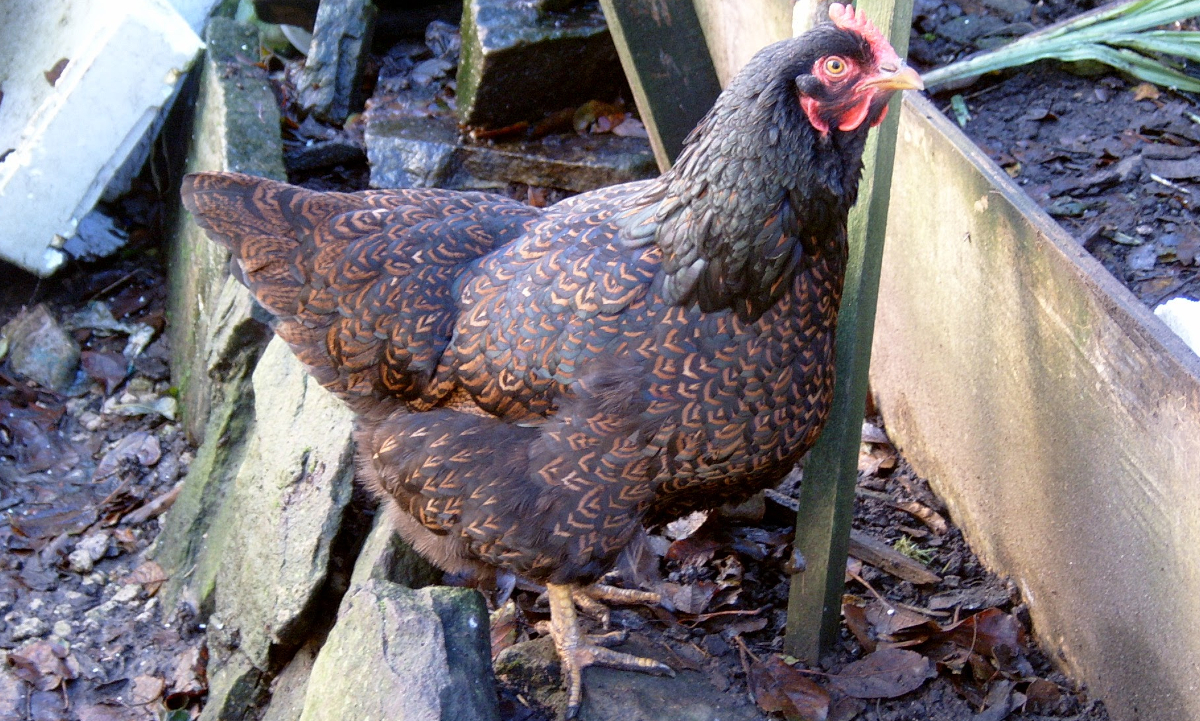
What is the crop?
The chickens crop is a muscular pouch located on the right side of a birds lower neck or upper breast area. The crop is purely a storage organ and no actual digestion takes place although it does moisten and mix food.
Birds have a small digestive system that work continuously and the crop is needed to fill the gaps in eating like overnight.
Below: The Crop on a Rhode Island Red.
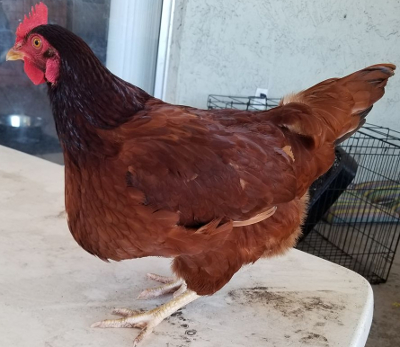
The crop feeds a steady supply of food to the gizzard where all the feed, grass and insects the bird just ate gets ground up.
The crop slowly contracts and pushes small amounts of food down through the tube toward the Proventriculus or stomach, through the gizzard and on through the Intestinal tract. When running properly, it is a very efficient system, with the crop playing a huge roll in the entire digestive tract.
Table of Contents
- What is the crop?
- What is the purpose of a chickens crop?
- Do chickens swallow food whole?
- How much feed does a chickens crop hold?
- What part of the chicken is the crop?
- How long does food stay in a chickens crop?
- How do you feel or check a chickens crop?
- How should a chickens crop feel?
- When is the best time to check a chickens crop?
- Why do chickens crops stop working properly?
- What are the symptoms of crop problems in chickens?
- What's wrong with my chickens crop?
- 1. Sour crop:
- 2. The Impacted crop:
- 3. Pendulous crop.
- 4. Infected crop:
- How do you prevent crop problems in chickens?
What is the purpose of a chickens crop?
The crop is a food storage organ. It holds and moistens the food mixing it up a little and feeding a steady stream of food through the tube toward the Proventriculus or stomach into the top of the gizzard.
All birds have them and chickens were given crops so they could go out into the field and gorge themselves, then run to cover and hide for hours or roost overnight digesting their meals.
So you could say the crop is a storage tank for food waiting to be digested. It can hold a surprising amount of feed.
An empty crop stimulates a chickens appetite, which is why they often eat so fast first thing in the morning when you let them out. A full crop is a signal to rest and stop eating which is why you often see hens resting up in the afternoon.
Do chickens swallow food whole?
All chickens swallow their food whole and do not chew their feed at all as they have no teeth. Either that or if it is too big to swallow whole they peck at it to break bits off which they swallow whole.
Below: This chickens is about to swallow a mouse whole.
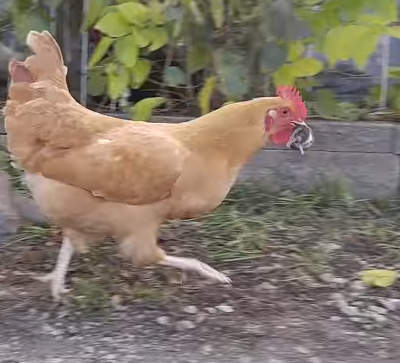
A chicken will pick up the food whole and then use the tongue to push it to the back of the mouth and down into its oesophagus and then into the crop for storage.
How much feed does a chickens crop hold?
At it's absolute maximum a full crop on a big large fowl chicken (Jersey Giant for example) can 6 cubic inches or 100 millilitres. This is about 3 quarters the size of a tennis ball. A golf ball is around 2.5 cubic inches or 40 millilitres.
It's normal range is around 50% of that and the chicken will gradually fill it during the day.
Below: Crops can look huge.
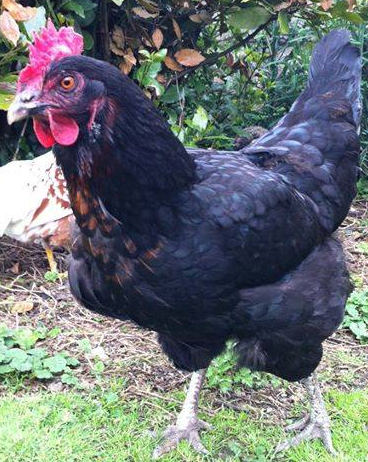
So if you feel a crop and it feels about the size of a gold ball then it has 2.5 cubic inches in it.
It sometimes looks bigger because of the feathers.
What part of the chicken is the crop?
The crop is a muscular pouch located 4 to 6 inches below the beak (depending on the size of the bird) and slightly to the side of its right breast muscle. It lies between the skin and the breast muscle.
It serves as a muscular pocket where food is stored after it's swallowed. It is like a flattened ball in shape normally, think balloon with water in squashed slightly between your hands.
Below: The crop is near the top of the digestive system.

The entire digestive system is about twelve inches or thirty centimetres long. The mouth at the beginning, the crop at 3 inches down, the stomach at 5 inches, the intestine makes up inches 6-11 and the rectum at 12 inches. If there is an infection or blockage anywhere along the digestive tract, the chicken can end up with a blocked Crop.
How long does food stay in a chickens crop?
Depending on what the bird has eaten it takes about 4 to 8 hours to completely empty a Crop. Moist chicken feed pellets are processed quite fast whereas whole grains may take a bit longer.
Crops can feel funky all day long and how they feel varies considerably over time. Soft and squishy, hard and firm.
Below: This is a pendulous crop and the never empty properly without help or a bra.

So make your assessment in the morning before the bird has eaten or drank anything. If you come to find a bird with a full crop in the morning, something is amiss with the digestion or the bird itself or it is doing something daft like eating the wood shavings off the floor.
And how does the crop store food for so long without growing bacteria you ask? A healthy crop is loaded with lots of good bacteria so when food sits in this pouch for hours on end, the good bacteria keep the food from growing toxins and harmful bacteria.
How do you feel or check a chickens crop?
Hold the chicken under your arm or get someone else to hold the bird. I hold it under my right and feel with my left.
To feel a crop you simply with the bird, beak facing away from you and you place your hand at the lower end of the neck where it meets the breast, and slide your hand down the front of the breast. The crop is on the right side of the bird's breast.
Below: Hold the chicken immobile and gently feel the crop.
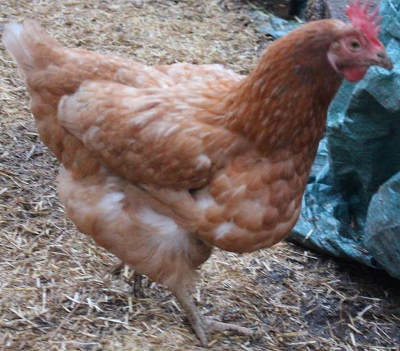
Lets start with giving the bird exams. Keeping tabs on your feathered friends is always the best way to keep them in good health. Along with the comb colour, the activity level of the bird, whether he or she is eating and drinking well, regularly checking the crop is a good way to monitor the health of your bird.
How should a chickens crop feel?
Lets start with the healthy Crop. A normal healthy chicken crop should feel like a bean bag. What you're feeling is the chickens feed, soaked up in water, which turns into mash.
Below: A large crop on it's own does not mean anything. This rooster has a huge crop but is completely healthy.
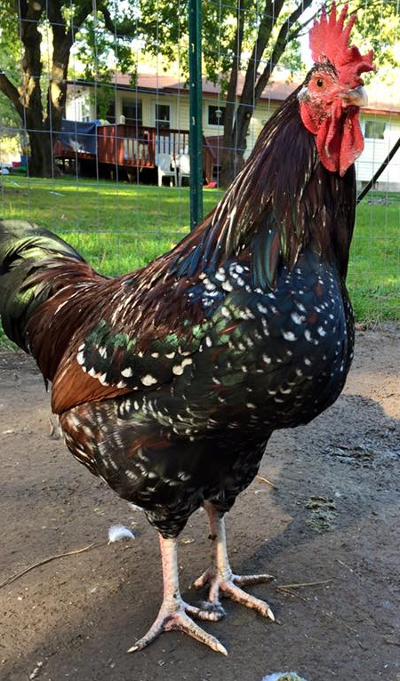
A bird that has a healthy fully functioning crop will always wake up with an empty crop and go to roost with a full crop. Birds like to stuff their crops full a few hours before roosting so they can get through the night with enough calories to stay warm and alive.
Below: Compare this chickens posture to the one above. This bird is unwell.
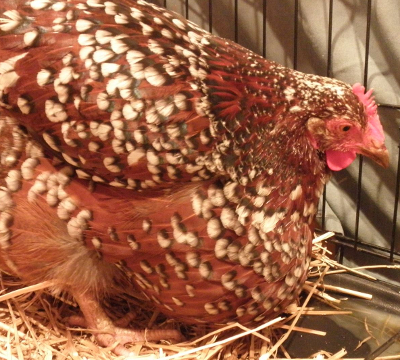
So upon inspection first thing in the morning before the bird has eaten or drank anything, the crop should be completely empty. Morning is the only time you can count on a crop to be empty with a healthy bird and the crop should feel like an empty bag and only just be noticeable.
A Normal chickens Crop feels like:
- An empty crop can almost or not be felt at all.
- A full crop can feel huge. A large crop on it's own is not an indication that something is wrong.
- The contents of a normal crop are mobile and can be manipulated with the fingers.
Abnormal Crop feels like:
- Hotter than normal.
- Solid round ball like a golf ball.
- Pendulous, hanging down like a shopping bag.
- Associated bad smell from the mouth.
- Slushy liquid filled crops can indicate a problem.
- If you can easily feel an empty crop there may well be a problem.
- Regurgitation. If the contents are regularly coming back up there may a problem.
- Anything in the crop in the morning.
If the chest is looking a little lopsided but they are eating, drinking, pooping, scratching and crowing, all is probably just fine. It is normal for their crops to look fuller towards the end of the day.
When is the best time to check a chickens crop?
You should check crops twice in the day. Firstly crops should be full when the chickens go to roost and empty when they get up in the morning. If a crop has anything in it after 8 hours overnight roosting then there is something wrong.
I check the crop at roosting time as well. This way I know if the bird is eating enough. crops should be full at roosting time. If they are empty, there is something going on with the bird.
If there is something in the crop in the morning, again, something is amiss. And if you are keeping regular tabs on the crop, you could potentially save your birds life having gotten treatment going early enough.
Why do chickens crops stop working properly?
Below are the reasons for crop issues or crop binding in chickens and some things that cause them to stop functioning properly:
- The chickens feed has changed.
- The Crop has become pendulous and slow.
- The Crop is Sour, possibly from Candidiasis, Yeast or other infection.
- The Crop is impacted with indigestible foodstuffs like long grass, feathers or too much whole grains.
- The Crop has Thread Worms.
- The Crop has been injured as sometimes happens when chicken fight.
- There is an impaction in the Gizzard or intestines.
- The Intestines are blocked by Worms.
- You have rescued ex battery or farm hens and the crops can not cope with solid feed.
- The bird is Egg Bound.
- Tumours have grown around the Intestinal tract blocking the passage of feed and the exit of waste.
- The bird has Water-belly (Ascites) .
- The bird is laying internally. A internally laid or stuck egg will block off the Intestinal tract.
- The bird has some sort of internal infection.
- The chicken is dying.
- Young birds stuff all sorts down their necks if they've not been raised properly.
Crop malfunctions which causes distress, illness and sometimes death to the bird. Food and waste need to keep moving through the system for the bird to take in nutrients and expel waste. If the intestinal tract shuts down, the bird can die.
What are the symptoms of crop problems in chickens?
- The chicken will look unwell and may be lethargic and even immobile.
- Birds fall forward with impacted crops and can't stand up properly.
- There may be as smell on the breath.
- The Crop could be a hard solid lump like a golf ball.
- The Crop could be loose, floppy and hanging down like a shopping bag.
- The crop could be filled with liquid.
Below: Classic forward heavy posture of an impacted crop.
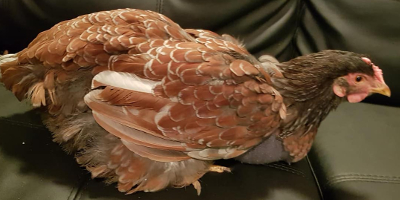
Or sometimes you may find the bird sitting in the corner somewhere looking sick and through an inspection of the bird, you find he or she has a full crop. However remember, other illness can cause the crop to stop working.
So you will need to do an overall exam of the bird to try to determine why the bird has this crop issue and what needs to be done to treat it.
What's wrong with my chickens crop?
There are 3 common and 1 not so common problems with chickens crops so we will start with those.
Diagnosis of a Crop issues and problems:
- Sour Crop.
- Impacted Crop.
- Pendulous Crop.
- Infected Crop.
1. Sour crop:
What is sour crop ?
The Slow or Sour Crop caused when the crop does not fully empty overnight. The contents can ferment or become infected or fungus can grow which might produce toxins. It can be caused by too many treats like bread or other soft feeds, worm infestations, infections or the consumption of long or fibrous grasses or even feathers.
Indigestible items like plastics and rubber bands can cause partial blockages and easily fermentable foodstuffs like pasta and sugar rich feed-stuffs can compound the issue.
How can you tell if chicken is sour crop?
I've had to deal with sour crop and it feels soft and squishy like a water balloon but with bits in it. It will not be empty in the mornings and there will be a smell from the beak.
Is Sour crop in chickens contagious?
In a word - NO. Sour crop in chickens is not contagious.
Can sour crop kill a chicken?
Yes. Chickens can die from sour crop. It may be the symptom of a deeper problem.
Sometimes a Slow or Sour Crop is stemmed from something more serious like Ascites, some internal infection, organ failure or the bird is simply dying. Generally when a bird is near death, the Intestinal Tract has shut down and liquid is filling these cavities.
How do you treat sour crop in chickens?
So you're in the coop one morning only to find a chicken with a full squishy Crop. Now what do you do? If it is day one and there are no other symptoms then it is considered slow at this point. Sour comes later after too much bad bacteria and yeast have been growing in the Crop from it emptying too slowly after a few days.
In most cases antibiotics are completely useless for sour Crop. They may be needed if there is and underlying problem. Also you may need to treat for worms.
First thing you need to do is get this gunk out of her crop. This stuff is going to become toxic very quick like and since chickens can't vomit, you will need to do it for them.
If left untreated, this gunk can poison her. So take her outside for this next procedure. Hold her like a football in one arm, beak facing out. With your other hand support her at the Crop.
Turn them upside down and gently massage from bottom to top for a few seconds at a time. Eventually the hen will regurgitate the contents.
Stand yourself with feet apart and lean yourself and the bird forward. You are going to want to lean her far down, beak facing the ground, tail up. Gently squeeze and massage the Crop.
The MOMENT the fluid starts to come up out and out of the beak, count to 2 or 3 and stand her and yourself back up. Any longer and you can aspirate her. Give her a few moments to catch her breath and do it again. Do this until you can't get any more out. You will never get it all out of the Crop, but do your best so she can heal faster and feel better as well.
Covering a treat in grit or DE ( diatomaceous earth) to ensure they are getting enough grit. - https://cluckin.net/diatomaceous-earth-and-how-to-use-it-for-chickens.html
I like to use a Crop Bra during times of Slow and Sour Crop. These garments are wonderful. The constant pressure against the Crop keeps food moving through the Crop and helps to prevent Souring since the food never sits too long.
They do have a disadvantage is they can effect the strength of the muscle overtime and make the problem worse.
She can eat only her chicken feed. It helps to dampen it with some water. Chickens love damp chicken feed and it helps to break it down easier so as to keep the Crop moving as fast as it can in it's condition. Absolutely no hard seeds, grains, grass or hard vegetation.
She can eat some warm, chopped hard boiled eggs with grit and natural yogurt on them for a treat. I am not a fan of using yogurt with Slow or Sour Crops as it can produce mucus which can slow a Crop down a bit. But it does have wonderful qualities of good bacteria and protein. So go ahead and use it sparingly if you want to.
Each morning you will need to check her Crop for fullness and vomit her if necessary. I do not like to vomit during the day. The bird needs to stay hydrated and fed. I only vomit during the day if she is leaking a lot of fluid from the beak. (Fluid leaking from the beak can also happen after a bird drinks too much water. So do not confuse over drinking of a healthy bird for a crop issue.
Remember to check crops in the morning or if they are definitely sick. Keep her caged and eating damp feed only. Don't re-feed damp feed from yesterday in case it has grown bacteria so only dampen a small amount at a time for that day.
If at any time her breath starts to smell badly or you are seeing white chunks in her vomit, then the Slow Crop has now become a Sour Crop. Medications will now be needed.
If you can get your vet to prescribe you Clotrimazole, then do it! This stuff is very powerful and will knock out the most powerful yeast infection a bird can have.
If is often given to human babies with Thrush of the mouth with great success. However if you don't have an avian vet or they do not have this medication, you can turn to vaginal cream. Yes, sounds bizarre, but I was directed by an avian vet to use this on my Chronically Slow and Sour Crop patient. And it wasn't until I started with the vaginal cream was I able to save my bird.
However just keep in mind, if something like the feed is causing this yeast infection or she has an internal infection, Crop worms, she is Egg Bound, intestinal worms or something else is causing this Crop to be slow and sour, you will need to correct these first before you can cure your bird of this yeast infection.
Once you can go two mornings with nothing in the Crop, you can assume you have cured the bird of this issue. She can then go back to her regularly scheduled day. Keep her on probiotics for one week after treatment.
What causes sour Crop?
Slow and Sour Crops can be caused by many things like feed changes, some new food that gave the bird indigestion, feed that has gone bad, mouldy or buggy, and sometimes certain birds just cannot digest certain feeds. I have also found it to be a common problem with rescued battery or egg farm hens.
Take her back inside. She will need to be caged but this time she can have food and water. Many times a slow Crop stems from the good bacteria in the Crop has diminished enough to slow the Crop down. The Crop being a muscle, works in conjunction with the good bacteria in the entire system.
2. The Impacted crop:
If you go to the coop in the morning and you do a Crop check only to find what feels like a hard ball in one of your hens Crops. An impacted crop feels like a golf ball. If it's not too bad then it will feel a little soft and doughy.
What is crop impaction?
The impacted or blocked Crop is when it becomes completely bunged and forms a solid lump that just won't shift naturally.
Below: An X-ray of an impacted Crop.
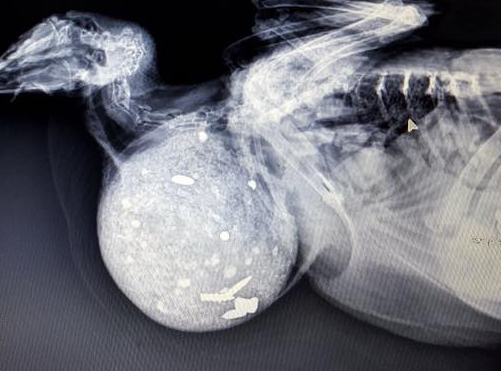
A full Crop will stop a chicken eating as well and needs to be treated quickly. Impaction is another issue that is best diagnosed in the mornings when the crops should be empty.
What causes impacted crops?
Complete blockages from things like long grass, twine or plastic. Also complete intestinal blockages caused by worms or infection. It can also be caused by the over consumption of dry pelleted chickens feed that then swells and sets solid with the addition of a little water.
I have also seen and impacted Crop blocked by feathers.
Can chickens die from impacted crop?
Yes they can, and quickly as well. Impacted Crop means the chicken is not getting any food and if there is an underlying infection or worm infestation then the bird is likely to be suffering from malnutrition already.
This can be a very dangerous situation if left untreated. The food in the crop is going to start to turn toxic and could potentially kill your bird. This impaction could also be lower in the gizzard or even in the Intestinal Tract as well.
How do you treat crop impaction?
Mild cases can be treated with massage and putting the bird onto water for 1 to 2 days and monitor. Some say a few drops of olive oil can help get things moving but warm water is just as likely to help get things mobile in the crop.
If the bird has been eating fibrous vegetation the fine pigeon grit or diatomaceous earth may help. Although this is not the function of the crop it is a muscular organ and does hold all the feed before it passes down to the gizzard.
Below: Impacted crop often have to be treated with surgery by a vet. Chickens do not recover well from general anaesthetics so it is usually local.
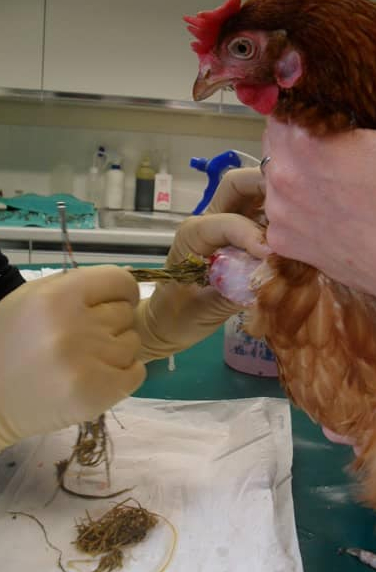
I like to stop and think for a moment as to why this bird might have an impaction so I can properly treat the bird. Have I wormed my birds lately? Round Worms can over populate the Intestinal Tract to the point of blocking off the entire passage of waste unable to leave the bird, thus causing the crop to become impacted.
Has the bird been laying regularly and possibly is she Egg Bound, causing the crop to become impacted? Does my bird have Ascites or a Water Belly? This is an easy exam to do. Feel between the abdomen between the legs and up to the vent on the outside of the bird. It should be small and firm, not large, soft and squishy. Generally this is going to be a life threatening situation and most likely the bird is not going to survive.
Below: Chickens eating feathers can block a crop. This sort of obstruction is likely to need surgery.
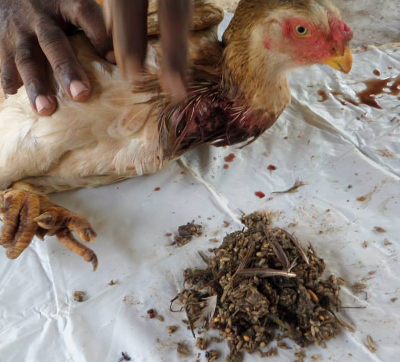
Long grass can wind around and around into a ball in the crop and become difficult for the bird to move. This long grass or stiff foliage can cause a gizzard impaction as well or even an Intestinal impaction. These examples are the most common reasons a crop becomes impacted.
First thing you need to do is confine her to a cage with no food. You do not want to add to this situation since nothing is moving through her. She will not starve to death in the amount of time it takes to get this moving.
Caging her will also allow you to monitor her poop output which is very important to knowing you are working this impaction out. All she can have at this time is water. Water, water and more water! Water will help to make this hard ball break down and move.
She will need to remain in this cage until roosting time with only water in her cage.
However there is few things you also need do to get this impaction broken up and moving.
However lets say on that first morning after having spent the day in a cage with only water you find little if anything has moved. Time to step it up a bit further. She will require another day of caging. She will no doubt be getting hungry at this point, but she will not starve just yet. So put her back in the cage.
Serious cases are likely to require surgery by a Vet to remove the ball. With impaction you should not try to empty the crop by vomiting the bird, a ball of fibrous matter is not likely to come out that way.
3. Pendulous crop.
What is pendulous crop?
The Crop, being a muscle, can stretch over time if the bird has a full Crop for months on end. It becomes what is called Pendulous.
Below: An Xray of a pendulous crop. You can see how it hangs down.

When this happens, the Crop will get so large and distended that it will be unable to empty out completely which can lead to chronic slow and sour Crop for the rest of the birds life.
A Crop Bra will help birds with Pendulous Crops empty their Crops and remain healthy if they continuously wear these.
There is no real treatment other than the bra and no cure as such. One the muscle has been damaged the Crop will hang down for the rest of the chickens life.
A pendulous Crop can upset the balance of a head and cause them to flop forwards.
4. Infected crop:
Infected crops are not common but do happen occasionally. If the skin feels unusually warm over the Crop area this may be a problem.
If the bird has been developing a crop issue that has gone unnoticed by you for some time, you may happen to pick up your bird and have it empty the contents of it's full crop on you, with liquid pouring out of the beak.
How do you prevent crop problems in chickens?
Prevention is always the best medicine like regular crop checks in the mornings. The faster you find these issues, the quicker you can get your bird back on the road to good health. The longer a bird remains sick, the chances of the illness becoming more serious and likeliness of death becomes more probable.
It is know that free range chickens suffer less crop problems than confined birds. The Crop is a muscular pouch that needs to be used to keep it in shape.
Use Probiotics like fermented feed on a regular basis. As I described above, they work to keep the good bacteria alive in the entire Intestinal Tract and boost immunity.
Apple Cider Vinegar. I don't recommend this to be used on a weekly regular basis, but one week a month can help to raise the PH level of the entire body.
Be careful with feed changes. Just as we humans get indigestion, so do birds. Small things like this can throw off the good bacterial balance in the Crop and Intestines. So mix in new feed slowly. And if you find a bird that you just can't cure with the above techniques and think she could possibly have an issue with feed, by all means change to a new feed.
WORM your birds!! I can't say enough about keeping your birds Intestines free from worm impactions. Worms will drain the life right out of a bird and can block the entire Intestinal Tract up completely.
Some say to keep your grass cut short and that long thick grass can wind up in a crop and stop it up completely. I would say that it has more to do with how fibrous the greenery is that your chickens are eating. Mine tend to nip the fresh green growing ends of the blades of grass.
Keep those eggs moving with a good diet, Grit, oyster shell and diatomaceous earth on the side.
Avoid too many hard to digest treats. Raisins and peanuts are wonderful treats. But they can be hard to break down or contain too much sugar. Bread is not good for chickens.
Always keep grit available at all times if the birds are kept in a run and don't have access to natural grit or sand. Grit is very important for the Gizzard to grind up all hard foods. And if you have only started free ranging your birds, start with small times out side on the grass. Gizzards are also a muscle and need to develop strength over time to be able to grind up all these hard foods.
Keep your facilities as clean as possible.
Don't let your chickens bully each other, give them plenty of space in the coop and run.
For a complete list of what you can safely feed your chickens to keep them healthy.
